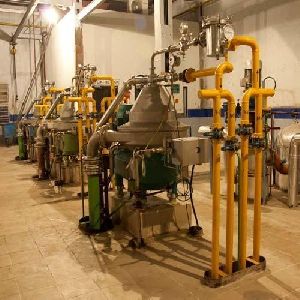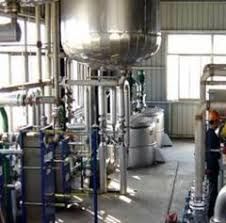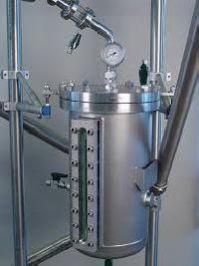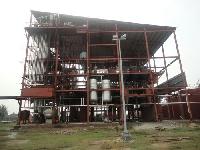
Vanaspati Hydrogenation Plant
Get Price Quote
1 Unit (MOQ)
Features Continuous bleaching, neutralization, deodorization along with post bleaching and post neutralization sections. Optimized process condition for proper selectivity and product consistency. Zero wastage of hydrogen gas and nickel catalyst.

Hydrogenation Reactors
Get Price Quote
1 Piece (MOQ)
Best Deals from Hydrogenation Plant

Hydrogenation Vanaspati Plants
Get Price Quote
Hydrogenation Vanaspati Plant Hydrogenation Vanaspati Plants are extension of hydrogenation plant. They are producing hydrogenated vegetable oils suitable for edible purpose in the form similar to balter / margarine / Vanaspati – a product similar to margarine, is very commonly used in Indian sub-continent as a cooking medium. Sundex offer wide range of Vanaspati plants.Hydrogenation PlantsSUNDEX offers its clients a wide range of Hydrogenation Plants that is used to extract oil. The oils and fats are a group of organic compounds called 'Fatty Acids' and form a vital part of daily food, which is used as a raw material for making soap. These fatty acids are made up of union of several carbon atoms in a straight chain with hydrogen and oxygen atoms. Further, a single chain comprises 6 to 24 carbon atoms, wherein 12,14,16,18 and 20 carbon chains are common. When the fatty acid reaches saturation point and the combination of carbon atoms with hydrogen is incomplete there is a possibility of further addition of hydrogen. More the un-saturation lower is the melting point of fatty acid as such, many oils containing un-saturation remains as liquids at normal temperatures. Besides, the ones that contain low amount of un-saturated acids become solid or semi solid fats at normal temperatures.Apart from this, the liquid oil can be converted to a required degree of hardness by reducing its un-saturation with the controlled reaction with hydrogen. Thus, vanaspati is such a product obtained by controlled hydrogenation of edible liquid oils (called 'soft oils' in the industry, this ensures that its hardness, consistency and grainy appearance resemble natural ghee. The addition of hydrogen in oil occurs when the hydrogen gas is brought in contact with the oil at a higher temperature in the presence of metallic nickel catalyst prepared under controlled conditions. Therefore, the process is not simple, it involves several steps, which can be performed with the help of these Hydrogenation Plants.HydrogenationThe extensive range of Hydrogenation offered by us is developed in tandem with the set industry standards. These are used for increasing of the melting point of unsaturated oils, fats and fatty acids. The Hydrogenation reaction is carried out under hydrogen gas pressure in presence of nickel catalyst, high temperature and nil moisture conditions. These hardened fats are then used generally in combination for the formulation and processing of vegetable ghee (vanaspati), margarine, shortening, confectionery and other cooking fats.Specifications:Dimension(L*W*H): 2000x1400 mmPower(W): 22 kwVoltage: 380V/50Hz

Hydrogenation Plant
Get Price Quote

Hydrogenation Plant
Get Price Quote

Hydrogenation Plant
Get Price Quote
This process may be performed either before or after splitting. In the presence of a catalyst, a reaction is conducted between the ethylenic double bond of an unsaturated fat and hydrogen. A typical Hydrogenation Process is conducted at temperatures ranging from 180 degrees to 250 degrees Celsius. The ideal pressure is between 10 to 25 bars in the presence of a catalyst supported on silica gel. The hydrogenation process comprises of an exothermic reaction and the heat is used for pre heating the fat. The resulting fat which is hydrogenated is filtered followed by post refining by filtering through activated bleaching earths to remove any trace of nickel.

Hydrogenation Plant
Get Price Quote
The company is engaged in producing an advanced range of Hydrogenation Plant that ensures the premium quality to fulfill the specific requirements of our clients. The plant can be used for producing hard fats of same quality required for formulating and processing food products like vegetable ghee, margarine, shortening, confectionery fats and other cooking fats. Our Hydrogenation Plant allows the oils and fats to be neutralized and bleached, removing traces of soap and impurities that may poison the metal catalyst.

Hydrogenation Plant
Get Price Quote
Hydrogenation which is also called fat modification, is unique 3 phase system of solid (catalyst), liquid oil and gas (hydrogen). The addition of hydrogen at double bond of fatty acid convert the unsaturated fatty acid into saturated fatty acid. The special design of autoclave results in lowest consumption of hydrogen gas and produces light color hydrogenated product.

Hydrogenation Plant
Get Price Quote
Hydrogenation is the process to change the physical characteristics of natural fats and oils. Hydrogenation of vegetable oils involves the addition of hydrogen, in the presence of a Nickel catalyst, to the carbon-carbon double bonds present in the fatty acid chains. Salient features: High degree of Auomization to control flow, temperature and pressure in Autoclave ensures selective hydrogenation and excellent quality product. 100% reproducibility of product is ensured. Almost zero steam consumption for heating. Steam is needed only once for the first charge of oil while starting the plant operation. This is achieved with the most efficient design of oil to oil Heat Exchanger. Practically maintenance free due to low speed agitation system in Autoclave. Low power and catalyst consumption. Interesterification Interesterification can be defined as a redistribution of the fatty acid moieties present in a triglyceride oil over its glycerol moieties. Interesterification has become the alternative fat modification technology to partial HYDROGENATION. Interstification is the process of re-arranging the fatty esters within and between tri-glycerides resulting in the most cases a change in the physical properties of the oil / fats. Interstification is the intra and inter molecular exchange of fatty acids on the glycerol back bone of tri glycerides. In the chemical Interstification process commonly used catalysts are sodium methylate and ethylate followed by sodium methoxide. In enzymatic Interstification process, the enzyme commonly used is lipozyme TL1M.

Hydrogenation Plant
Get Price Quote
we provide hydrogenation plant that includes autoclave for edible oils of any capacity ranging up to 20 tons charge along with a heat exchanger, which can produce up to 5 batches per day. These are achieved with the help of unique designs of agitation system in autoclave. To ensure selective hydrogenation and excellent quality product, high degree of atomization to control flow, temperature and pressure in autoclave are used. Featured with zero steam consumption these are achieved with the most efficient design of oil-to-oil heat exchanger. our hydrogenation plant is easy to use and maintain as well.

Hydrogenation Plant
Get Price Quote
Hydrogenation of Nitro Cumene to Cumidine in presence of catalyst , To conduct gasliquid solid reaction. Plant Details:Operating Temperature: 150°C, Operating pressure:40 bar.g, Unit included: stirred tank reactor (MOC: SS316L) with variable, speed magnetic drive and having screw type manual, lifting arrangement for reactor, PC-PLC based control System.

Hydrogenation Plant
80,000,000 Per Unit
1 Unit (MOQ)

Hydrogenation Plant
Get Price Quote
Hydrogenation is the process to change the physical characteristics of natural fats and oils. Hydrogenation of vegetable oils/fatty acids involves the addition of hydrogen, in the presence of a Nickel catalyst, to the carbon-carbon double bonds present in the fatty acid chains. Salient features High degree of Automization to control flow, temperature and pressure in Autoclave ensures selective hydrogenation and excellent quality product. 100% reproducibility of product is ensured. Almost zero steam consumption for heating. Steam is needed only once for the first charge of oil while starting the plant operation. This is achieved with the most efficient design of oil to oil Heat Exchanger. Practically maintenance free due to low speed agitation system in Autoclave. Low power and catalyst consumption

hydrogenation plants
50 Per Piece

Hydrogenation Plant
Get Price Quote
Hydrogenation Plant, Acid Oil Plant, Seed Elevator, Horizontal Cooler

Hydrogenation Plant
Get Price Quote
Hydrogenation Plant, Palm Oil Milling Machine, fatty acid plant

Hydrogenation Plant
Get Price Quote
Hydrogenation Plant, degumming plant, turnkey project engineering

Hydrogenation Plant
Get Price Quote
Hydrogenation Plant, Oil Seed Processing Machineries, expellers

hydrogenation plants
Get Price Quote
hydrogenation plants, Water Treatment Plants, effluent water treatment plants

Skid Mounted Hydrogenation Plants
Get Price Quote
Skid Mounted Hydrogenation Plants